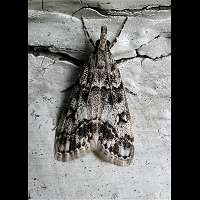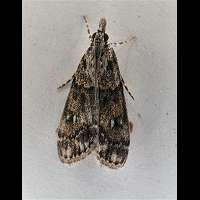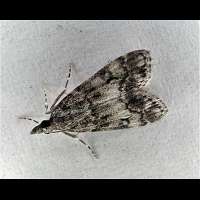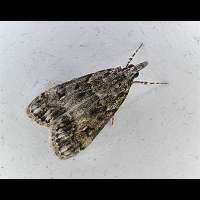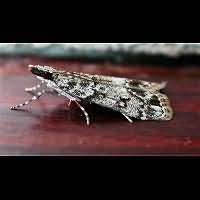Dipleurina lacustrata
Dipleurina lacustrata is widely distributed all over England, Wales and Ireland and is also found in southern parts of Scotland. In the Benelux the species is not very common, though. It is a very small species, having a wingspan of up to 18 mm only. The larvae feed on mosses and lychens, usually those growing on tree trunks, rocks and walls. The species flies about in June and July mainly. It is extremely similar to some other species, including Eudonia truncicolella and Scoparia ambigualis. Characteristics for the three species are as follows:
The black spot resembling an x, usually looks like an x in Scoparia ambigualis and Eudonia truncicolella. However in Dipleurina lacustrata it does look more like a c. The wings of Scoparia ambigualis are broader than those of the other two species. The dark line just in front of of the white is best developed in Dipleurina lacustrata, less so in Scoparia ambigualis and least in Eudonia truncicolella. Eudonia truncicolella is rather black and white lacking brownish tones so visible in Scoparia ambigualis. Eudonia truncicolella and Dipleurina lacustrata don't fly in May and the first half of June, Scoparia ambigualis however does.
Do keep in mind though that you can never be sure, for especially Scoparia ambigualis is very variable. The only way to tell them apart for sure is by examining the genitals. And when you are a beginner do take good pictures and present them to experienced microlepidopterists, or on a good forum on the internet.
Dipleurina lacustrata is also known as Dipleurina crataegella and Dipleurina centurionalis,
Dipleurina lacustrata is widely distributed all over England, Wales and Ireland and is also found in southern parts of Scotland. In the Benelux the species is not very common, though. It is a very small species, having a wingspan of up to 18 mm only. The larvae feed on mosses and lychens, usually those growing on tree trunks, rocks and walls. The species flies about in June and July mainly. It is extremely similar to some other species, including Eudonia truncicolella and Scoparia ambigualis. Characteristics for the three species are as follows:
The black spot resembling an x, usually looks like an x in Scoparia ambigualis and Eudonia truncicolella. However in Dipleurina lacustrata it does look more like a c. The wings of Scoparia ambigualis are broader than those of the other two species. The dark line just in front of of the white is best developed in Dipleurina lacustrata, less so in Scoparia ambigualis and least in Eudonia truncicolella. Eudonia truncicolella is rather black and white lacking brownish tones so visible in Scoparia ambigualis. Eudonia truncicolella and Dipleurina lacustrata don't fly in May and the first half of June, Scoparia ambigualis however does.
Do keep in mind though that you can never be sure, for especially Scoparia ambigualis is very variable. The only way to tell them apart for sure is by examining the genitals. And when you are a beginner do take good pictures and present them to experienced microlepidopterists, or on a good forum on the internet.
Dipleurina lacustrata is also known as Dipleurina crataegella and Dipleurina centurionalis,

